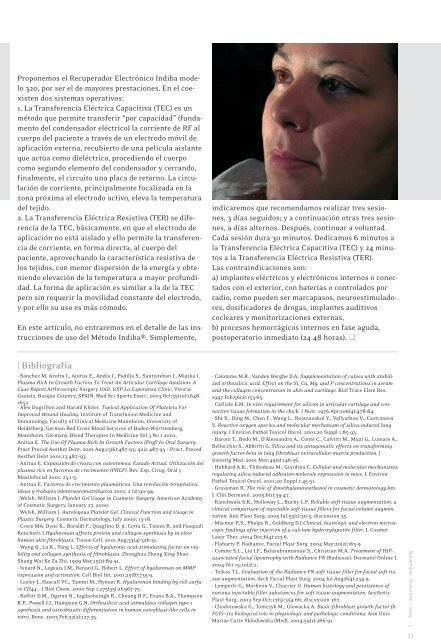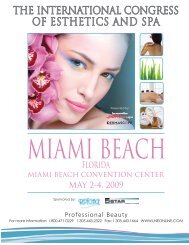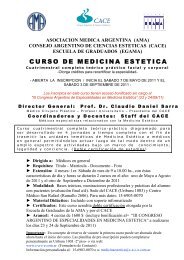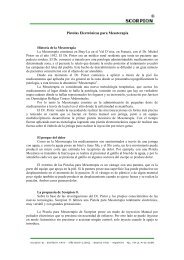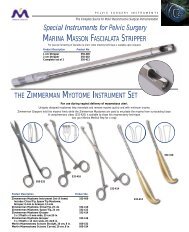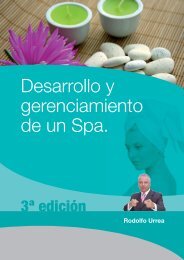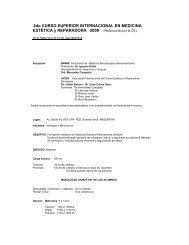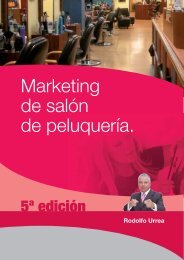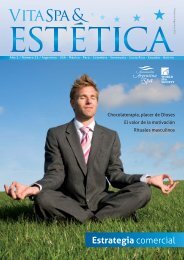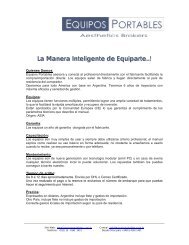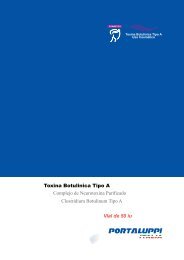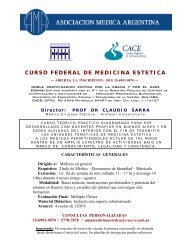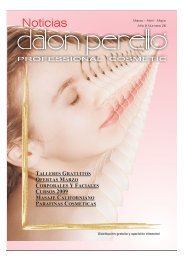Breve reseña histórica - Estheticnet
Breve reseña histórica - Estheticnet
Breve reseña histórica - Estheticnet
You also want an ePaper? Increase the reach of your titles
YUMPU automatically turns print PDFs into web optimized ePapers that Google loves.
Proponemos el Recuperador Electrónico Indiba modelo<br />
320, por ser el de mayores prestaciones. En el coexisten<br />
dos sistemas operativos:<br />
1. La Transferencia Eléctrica Capacitiva (TEC) es un<br />
método que permite transferir “por capacidad” (fundamento<br />
del condensador eléctrico) la corriente de RF al<br />
cuerpo del paciente a través de un electrodo móvil de<br />
aplicación externa, recubierto de una película aislante<br />
que actúa como dieléctrico, procediendo el cuerpo<br />
como segundo elemento del condensador y cerrando,<br />
finalmente, el circuito una placa de retorno. La circulación<br />
de corriente, principalmente focalizada en la<br />
zona próxima al electrodo activo, eleva la temperatura<br />
del tejido.<br />
2. La Transferencia Eléctrica Resistiva (TER) se diferencia<br />
de la TEC, básicamente, en que el electrodo de<br />
aplicación no está aislado y ello permite la transferencia<br />
de corriente, en forma directa, al cuerpo del<br />
paciente, aprovechando la característica resistiva de<br />
los tejidos, con menor dispersión de la energía y obteniendo<br />
elevación de la temperatura a mayor profundidad.<br />
La forma de aplicación es similar a la de la TEC<br />
pero sin requerir la movilidad constante del electrodo,<br />
y por ello su uso es más cómodo.<br />
En este artículo, no entraremos en el detalle de las instrucciones<br />
de uso del Método Indiba®. Simplemente,<br />
| Bibliografía<br />
- Sánchez M. Azofra J., Anitua E., Andia I., Padilla S., Santisteban J., Mujika I.<br />
Plasma Rich In Growth Factors To Treat An Articular Cartilage Avulsion: A<br />
Case Report.Arthroscopic Surgery Unit, USP-La Esperanza Clinic, Vitoria-<br />
Gasteiz, Basque Country, SPAIN. Med Sci Sports Exerc. 2003 Oct;35(10):1648-<br />
1652.<br />
- Alex Dugrillon and Harald Klüter. Topical Application Of Platelets For<br />
Improved Wound Healing. Institute of Transfusion Medicine and<br />
Immunology, Faculty of Clinical Medicine Mannheim, University of<br />
Heidelberg, German Red Cross Blood Services of Baden-Württemberg,<br />
Mannheim, Germany. Blood Therapies In Medicine Vol 3 No 1 2002.<br />
Anitua E. The Use Of Plasma-Rich In Growth Factors (Prgf) In Oral Surgery.<br />
Pract Proced Aesthet Dent. 2001 Aug;13(6):487-93; quiz 487-93 / Pract. Proced<br />
Aesthet Dent 2001:13:487–93.<br />
- Anitua E. Expansión de cresta con osteotomos: Estado Actual. Utilización del<br />
plasma rico en factores de crecimiento (PRGF). Rev. Esp. Cirug. Oral y<br />
Maxilofacial 2001; 23:1-5.<br />
- Anitua E. Factores de crecimiento plasmáticos. Una revolución terapéutica.<br />
Ideas y trabajos odontoestomatológicos 2001; 2 (2):90-94.<br />
- Welsh, William J. Platelet Gel Usage in Cosmetic Surgery. American Academy<br />
of Cosmetic Surgery, January 27, 2000.<br />
- Welsh, William J. Autologous Platelet Gel. Clinical Function and Usage in<br />
Plastic Surgery. Cosmetic Dermatology, July 2000; 13-18.<br />
- Croce MA, Dyne K., Boraldi F., Quaglino D. jr, Cetta G., Tiozzo R. and Pasquali<br />
Ronchetti I.Hyaluronan affects protein and collagen synthesis by in vitro<br />
human skin fibroblasts. Tissue Cell. 2001 Aug;33(4):326-31.<br />
- Wang Q., Lu K., Yang L. Effects of hyaluronic acid-stimulating factor on viability<br />
and collagen synthesis of fibroblasts. Zhonghua Zheng Xing Shao<br />
Shang Wai Ke Za Zhi. 1999 Mar;15(2):89-91.<br />
- Isnard N., Legeais J.M., Renard G., Robert L. Effect of hyaluronan on MMP<br />
expression and activation. Cell Biol Int. 2001;25(8):735-9.<br />
- Lesley J., Hascall VC., Tammi M., Hyman R. Hyaluronan binding by cell surface<br />
CD44. - J Biol Chem. 2000 Sep 1;275(35):26967-75.<br />
- Reffitt D.M., Ogston N., Jugdaohsingh R., Cheung H.F., Evans B.A., Thompson<br />
R.P., Powell J.J., Hampson G.N. Orthosilicic acid stimulates collagen type 1<br />
synthesis and osteoblastic differentiation in human osteoblast-like cells in<br />
vitro. Bone. 2003 Feb;32(2):127-35.<br />
indicaremos que recomendamos realizar tres sesiones,<br />
3 días seguidos; y a continuación otras tres sesiones,<br />
a días alternos. Después, continuar a voluntad.<br />
Cada sesión dura 30 minutos. Dedicamos 6 minutos a<br />
la Transferencia Eléctrica Capacitiva (TEC) y 24 minutos<br />
a la Transferencia Eléctrica Resistiva (TER).<br />
Las contraindicaciones son:<br />
a) implantes eléctricos y electrónicos internos o conectados<br />
con el exterior, con baterías o controlados por<br />
radio, como pueden ser marcapasos, neuroestimuladores,<br />
dosificadores de drogas, implantes auditivos<br />
cocleares y monitorizaciones externas,<br />
b) procesos hemorrágicos internos en fase aguda,<br />
postoperatorio inmediato (24-48 horas). <br />
- Calomme M.R., Vanden Berghe D.A. Supplementation of calves with stabilized<br />
orthosilicic acid. Effect on the Si, Ca, Mg, and P concentrations in serum<br />
and the collagen concentration in skin and cartilage. Biol Trace Elem Res.<br />
1997 Feb;56(2):153-65.<br />
- Carlisle E.M. In vivo requirement for silicon in articular cartilage and connective<br />
tissue formation in the chick. J Nutr. 1976 Apr;106(4):478-84.<br />
- Shi X., Ding M., Chen F., Wang L., Rojanasakul Y., Vallyathan V., Castranova<br />
V. Reactive oxygen species and molecular mechanism of silica-induced lung<br />
injury. J Environ Pathol Toxicol Oncol. 2001;20 Suppl 1:85-93.<br />
- Baroni T., Bodo M., D’Alessandro A., Conte C., Calvitti M., Muzi G., Lumare A.,<br />
Bellocchio S., Abbritti G. Silica and its antagonistic effects on transforming<br />
growth factor-beta in lung fibroblast extracellular matrix production. J<br />
Investig Med. 2001 Mar;49(2):146-56.<br />
- Hubbard A.K., Thibodeau M., Giardina C. Cellular and molecular mechanisms<br />
regulating silica-induced adhesion molecule expression in mice. J. Environ<br />
Pathol Toxicol Oncol. 2001;20 Suppl 1:45-51.<br />
- Grossman R. The role of dimethylaminoethanol in cosmetic dermatology.Am<br />
J. Clin Dermatol. 2005;6(1):39-47.<br />
- Kanchwala S.K., Holloway L., Bucky L.P. Reliable soft tissue augmentation: a<br />
clinical comparison of injectable soft-tissue fillers for facial-volume augmentation.<br />
Ann Plast Surg. 2005 Jul;55(1):30-5; discussion 35.<br />
- Marmur E.S., Phelps R., Goldberg D.J.Clinical, histologic and electron microscopic<br />
findings after injection of a calcium hydroxylapatite filler. J. Cosmet<br />
Laser Ther. 2004 Dec;6(4):223-6.<br />
- Flaharty P. Radiance. Facial Plast Surg. 2004 May;20(2):165-9<br />
- Comite S.L., Liu J.F., Balasubramanian S., Christian M.A. Treatment of HIVassociated<br />
facial lipoatrophy with Radiance FN (Radiesse). Dermatol Online J.<br />
2004 Oct 15;10(2):2.<br />
- Tzikas T.L. Evaluation of the Radiance FN soft tissue filler for facial soft tissue<br />
augmentation. Arch Facial Plast Surg. 2004 Jul-Aug;6(4):234-9.<br />
- Lemperle G., Morhenn V., Charrier U. Human histology and persistence of<br />
various injectable filler substances for soft tissue augmentation. Aesthetic<br />
Plast Surg. 2003 Sep-Oct;27(5):354-66; discussion 367.<br />
- Chodorowska G., Tomczyk M., Glowacka A. Basic-fibroblast growth factor (b-<br />
FGF)—its biological role in physiologic and pathologic conditions. Ann Univ<br />
Mariae Curie Sklodowska [Med]. 2004;59(1):286-91.<br />
Noviembre - Diciembre / 2007<br />
23


